How to Write a Formal Essay: Format, Rules, & Example
If you’re a student, you’ve heard about a formal essay: a factual, research-based paper written in 3rd person. Most students have to produce dozens of them during their educational career.
Our specialists will write a custom essay specially for you!
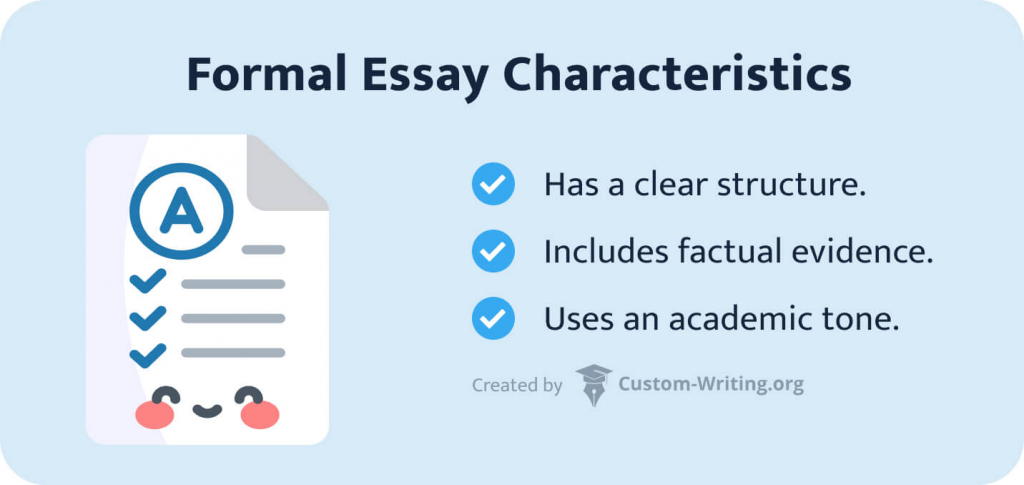
Writing a formal essay may not be the easiest task. But fear not: our custom-writing team is here to guide you through the process. This article will:
- explain what a formal essay is;
- show how to write it step by step;
- provide you with an essay sample.

👔 Formal Essay Definition
- ✅ How to Write
- ✍️ Writing Rules
- 🖥️ Essay Format
- 📑 Sample Paper
🔍 References
A formal essay is a well-structured piece of writing with a clear introduction, body, and conclusion. This type of essay often includes cited research, uses an academic tone, and is written in 3rd person. While writing a formal essay, it’s necessary to back up your arguments with factual evidence.
What Is an Informal Essay vs. Formal Essay?
Essays come in two formats: formal and informal (also known as personal .) They differ in terms of style and context. You can choose one of the formats depending on the situation and the type of paper you need to write.
Don’t know how to tell the difference between them? Well, here are some key characteristics of these essay types:
As you can see, these types of writing are almost total opposites. Informal essays are only reserved for creative assignments, which means that most of the papers you write need to be formal.
Just in 1 hour! We will write you a plagiarism-free paper in hardly more than 1 hour
Our article on creative essays can help you write an informal paper. But how do you craft a perfect formal essay? Keep reading to find out.
✅ How to Write a Formal Essay
Traditionally, a formal essay it’s composed of 3 sections: an introduction, 3 or more body paragraphs, and a conclusion. Let’s examine each part in detail.
Formal Essay Introduction
The introduction is what your essay starts with. Its primary goal is to catch the reader’s attention with a hook, briefly introduce the topic, and lead toward the thesis statement located at the end of the first paragraph.
Here is what you might want to keep in mind while writing the introduction:
If you want some more inspiration for your introduction, check out our article on hooks in writing .
Receive a plagiarism-free paper tailored to your instructions. Cut 15% off your first order!
Now on to the thesis statement : the key idea of your essay. When working on it, keep in mind that it should answer the central question in your topic and reflect your essay’s overall structure. your essay’s overall structure.
Suppose your topic is related to the teaching methods involving poetry. In that case, the thesis statement can be like this:
Teaching methods that involve reading and writing poetry in elementary school are beneficial for children as they enhance their capacity for empathy, develop creativity, and help with self-realization.
Formal Essay Body
The next part of an essay is the main body paragraphs. They support the thesis statement with well-developed arguments and explore the topic in-depth. Each body paragraph starts with a topic sentence stating its main point. The length of a paragraph can vary, but the best option is to have between 4 and 7 sentences.
To make the text flow easily, you may use transitional words. Here are some examples:
- after all,
- for instance,
- on the one/other hand,
- initially,
- as a result.
How to Write a Formal Essay Conclusion
Lastly, every essay needs closure. A good conclusion summarizes the essay’s main ideas, includes a paraphrased thesis, and encourages the readers to think more about the topic.
Get an originally-written paper according to your instructions!
The structure of a conclusion may change slightly depending on the subject. For instance, it can suggest some solutions to a problem, express an opinion, or give a recommendation. It’s important to remember that the conclusion is a part that emphasizes your essay’s most important points and doesn’t introduce new information.
If you’re curious about writing each essay part, check out our article on 5-paragraph essays .
✍️ Formal Writing Rules
Just like choosing the proper attire to wear to a formal event, we need to use the right words while writing a formal essay. Here are some suggestions that can help you maintain a formal tone in your paper:
Dos of formal writing
- Pay attention to your vocabulary. The words you will use in a formal essay will likely have a nuanced meaning. Make sure you know exactly what the terms mean, and do your best to sound precise.
- Use punctuation correctly. Here are some of the things to watch out for: Avoid exclamation marks; Use dashes for insertions; Use colons with enumerations; If you’re unsure of whether to use a punctuation mark or not, rewrite the sentence in a way that doesn’t require it.
- Use varied sentence structure. In formal writing, there is always a danger of sounding monotonous. Avoid repeating sentence structures to make your essay more readable.
- Provide references. It’s essential to cite every idea that you borrow. Try to paraphrase quotations from your sources: it will help you avoid plagiarism.
Don’ts of formal writing
- Avoid using pronouns. With words such as “I,” “me,” “we,” or “us,” an essay becomes wordy. It also makes the author seem less sure of their ideas. If you want to use personal pronouns, try substituting them with words like “the reader,” “viewers,” or “one.”
- Avoid using slang expressions and nonstandard diction. Slang words in a formal essay will make it less appealing to the readers. If you want to be taken seriously, it’s best to avoid those expressions and use proper Standard English.
- Avoid informal tone. When you write a formal essay, incorporate the language and the expressions you would use while delivering a speech, not the words you use when you casually talk to friends. A formal tone suggests that the author is serious about the topic and respects the audience.
- Avoid passive voice. Passive verbs are hard to read, and they are wordy. Use active voice to sound more straightforward and concise.
Contractions in Formal Writing
A contraction is usually a combination of two words into one, such as “don’t,” “isn’t,” “can’t,” and “wouldn’t.” When you work on a formal essay, it’s essential to be careful about contractions. It’s inappropriate to use them in academic writing, so it’s best to stick to the full variant.
However, there are exceptions to this rule. For instance, when working with direct quotations, it’s essential to reproduce words exactly as they are used in the original. To learn more about it, be sure to check out the University of North Florida’s article on in-text citations .
What to Use Instead of “You” in an Essay
Another common mistake students make is using the “you” and “yours” pronouns to address the readers. This mistake can make the essay overly informal and lead to misinterpretations of the text.
How do you fix it? Our advice is to replace 2nd-person pronouns with the following words:
- individuals,
You can find more formal writing tips in this informative video from Smrt English:
🖥️ Formal Essay Format
Now that we’ve discussed formal essay writing in detail, it’s time to look at the formatting. A formal essay is usually written in MLA or APA formats. If you’re asked to write a paper in one of these formats, you may find the guidelines below helpful:
📑 Formal Essay Example
Here is an excellent sample of a formal essay that uses all the guidelines mentioned in this article. It will help you to produce a perfect paper of your own:
For more information, check out Purdue OWL’s resources on various formatting styles .
Formal Essay Topics
- Stress management techniques
- The effects of coffee
- Negative effects of technology on children
- Causes and outcomes of organizational conflicts in sports
- Different types of friends
- Same-sex marriages in the United States
- Are early marriages harmful or beneficial?
- How do nutrition and hydration improve athletes’ performance?
- Is polygamy morally acceptable?
- Different features of sports business
- What characterizes friendship in the age of media ?
- Positive and negative effects of tourism on environment in the Caribbean
- How does society treat single parents ?
- How does the uninvolved parenting style affect child’s future well-being?
- The role of family relationships in Odyssey
- Financial concepts in sport finance
- Main features of a strong marriage
- The importance of media coverage for sport teams
- Reasons why students choose to get internship
- The role of stadiums in the sports industry
- The multiracial family: the Carters case analysis
- Characteristics of children’s sports
- Crucial factors affecting health fitness
- How is technology used in hotel management?
- Structure and operational context of Four Seasons
- What are the main qualities of a true friend?
- Different websites that promote rental properties
- The imperative aspects of tourism
- Importance of hotel training
- What factors determine adolescents’ adjustment after they experience parental divorce ?
- How does tobacco use affect the human body?
- The importance of language and world view for communication
- What makes a combination of reinforcement and punishment in parenting efficient?
- The scientific approach of sports economics
- How does divorce affect children?
- Living on-campus vs. living off-campus when attending university: a comparison
- How does the New Moves program promote a healthy lifestyle?
- How to be an effective counselor
- Various types of restaurants in Ireland
- Carolina Dog’s characteristics
- Comparison of Monzameon’s The Love Suicides at Amijima and Tartuffe by Moliere
- Comparing homosexual and heterosexual families
- How is family presented in Everyday Use by Alice Walker ?
- In what ways can Anaerobic Threshold be assessed?
- Is bad parenting a healthcare problem?
- Why student-athletes should benefit from sports
- Mind-body awareness and its health benefits
- Can punishment boost academic performance?
- Techniques to teach students swimming
- Issues faced by the sports licensing field
Thanks for reading through this guide! We hope that you found it helpful and now have a better idea of how to write an excellent formal essay. Don’t hesitate to share our article with a friend who may need it. Good luck!
Further reading:
- How to Write a Critical Thinking Essay: Examples & Outline
- What Is a Discourse Analysis Essay: Example & Guide
- How to Write a Narrative Essay Outline: Template & Examples
- How to Write a Précis: Definition, Guide, & Examples
❓ Formal Essay FAQs
It’s best not to use pronouns such as “I,” “my,” “we,” “our,” etc., in a formal essay since it give the paper an informal tone and the text becomes wordy. It also makes the writer seem less sure about their ideas.
It’s better to avoid using parentheses and dashes in formal academic writing. If the information you want to include in the essay is important enough, it should be a part of the sentence. Otherwise, you can simply omit it.
The formal and informal essays differ in style and context. While a formal essay is a piece of well-structured writing that tries to convince the reader by providing arguments, an informal essay has no set structure. It reflects the author’s personal thoughts or opinions.
Starting your sentence with “because” in formal writing is not the best idea. The word “because” is a subordinate conjunction, which means it’s used to join the main clause to a subordinate clause, not to start a sentence.
It’s best to avoid using 1st- and 2nd-person pronouns, slang expressions, nonstandard diction, and contractions in a formal essay. They are primarily used in daily speech and are considered inappropriate in academic writing.
- Point of View in Academic Writing: St. Louis Community College
- Components of a Good Essay: University of Evansville
- Introductions & Conclusions: University of Arizona Global Campus
- How to Improve Your Academic Writing: University of York
- Nine Basic Ways to Improve Your Style in Academic Writing: University of California, Berkeley
- Academic Writing Style: Organizing Your Social Sciences Research Paper: University of Southern California
- Formal and Informal Style: Northern Illinois University
- Formal Writing: Davenport University: LibGuides
- Share to Facebook
- Share to Twitter
- Share to LinkedIn
- Share to email

Rhetorical analysis is never a simple task. This essay type requires you to analyze rhetorical devices in a text and review them from different perspectives. Such an assignment can be a part of an AP Lang exam or a college home task. Either way, you will need a solid outline...

A synthesis essay requires you to work with multiple sources. You combine the information gathered from them to present a well-rounded argument on a topic. Are you looking for the ultimate guide on synthesis essay writing? You’ve come to the right place! In this guide by our custom writing team,...

A critical analysis essay is an academic paper that requires a thorough examination of theoretical concepts and ideas. It includes a comparison of facts, differentiation between evidence and argument, and identification of biases. Crafting a good paper can be a daunting experience, but it will be much easier if you...

Process analysis is an explanation of how something works or happens. Want to know more? Read the following article prepared by our custom writing specialists and learn about: process analysis and its typesa process analysis outline tipsfree examples and other tips that might be helpful for your college assignment So,...

A visual analysis essay is an academic paper type that history and art students often deal with. It consists of a detailed description of an image or object. It can also include an interpretation or an argument that is supported by visual evidence. In this article, our custom writing experts...

Want to know how to write a reflection paper for college or school? To do that, you need to connect your personal experiences with theoretical knowledge. Usually, students are asked to reflect on a documentary, a text, or their experience. Sometimes one needs to write a paper about a lesson...

A character analysis is an examination of the personalities and actions of protagonists and antagonists that make up a story. It discusses their role in the story, evaluates their traits, and looks at their conflicts and experiences. You might need to write this assignment in school or college. Like any...
![formal essay template Critical Writing: Examples & Brilliant Tips [2024]](https://custom-writing.org/blog/wp-content/uploads/2021/02/fingers-note-report-journalist-filling-284x153.jpg)
Any critique is nothing more than critical analysis, and the word “analysis” does not have a negative meaning. Critical writing relies on objective evaluations of or a response to an author’s creation. As such, they can be either positive or negative, as the work deserves. To write a critique, you...

If you are assigned to write a rhetorical analysis essay, you have one significant advantage. You can choose a text from an almost infinite number of resources. The most important thing is that you analyze the statement addressed to an audience. The task of a rhetorical analysis essay is to...

Any literary analysis is a challenging task since literature includes many elements that can be interpreted differently. However, a stylistic analysis of all the figurative language the poets use may seem even harder. You may never realize what the author actually meant and how to comment on it! While analyzing...

As a student, you may be asked to write a book review. Unlike an argumentative essay, a book review is an opportunity to convey the central theme of a story while offering a new perspective on the author’s ideas. Knowing how to create a well-organized and coherent review, however, is...

The difference between an argumentative and persuasive essay isn’t always clear. If you’re struggling with either style for your next assignment, don’t worry. The following will clarify everything you need to know so you can write with confidence. First, we define the primary objectives of argumentative vs. persuasive writing. We...
Essay Writing Guide
Essay Outline
Last updated on: Jun 10, 2023
A Complete Essay Outline - Guidelines and Format
By: Nova A.
13 min read
Reviewed By: Melisa C.
Published on: Jan 15, 2019

To write an effective essay, you need to create a clear and well-organized essay outline. An essay outline will shape the essay’s entire content and determine how successful the essay will be.
In this blog post, we'll be going over the basics of essay outlines and provide a template for you to follow. We will also include a few examples so that you can get an idea about how these outlines look when they are put into practice.
Essay writing is not easy, but it becomes much easier with time, practice, and a detailed essay writing guide. Once you have developed your outline, everything else will come together more smoothly.
The key to success in any area is preparation - take the time now to develop a solid outline and then write your essays!
So, let’s get started!

On this Page
What is an Essay Outline?
An essay outline is your essay plan and a roadmap to essay writing. It is the structure of an essay you are about to write. It includes all the main points you have to discuss in each section along with the thesis statement.
Like every house has a map before it is constructed, the same is the importance of an essay outline. You can write an essay without crafting an outline, but you may miss essential information, and it is more time-consuming.
Once the outline is created, there is no chance of missing any important information. Also, it will help you to:
- Organize your thoughts and ideas.
- Understand the information flow.
- Never miss any crucial information or reference.
- Finish your work faster.
These are the reasons if someone asks you why an essay outline is needed. Now there are some points that must be kept in mind before proceeding to craft an essay outline.

Easily Outline Your Essays In Seconds!
Prewriting Process of Essay Outline
Your teacher may ask you to submit your essay outline before your essay. Therefore, you must know the preliminary guidelines that are necessary before writing an essay outline.
Here are the guidelines:
- You must go through your assignments’ guidelines carefully.
- Understand the purpose of your assignment.
- Know your audience.
- Mark the important point while researching your topic data.
- Select the structure of your essay outline; whether you are going to use a decimal point bullet or a simple one.

Paper Due? Why Suffer? That's our Job!
How to Write an Essay Outline in 4 Steps
Creating an essay outline is a crucial step in crafting a well-structured and organized piece of writing. Follow these four simple steps to create an effective outline:
Step 1: Understand the Topic
To begin, thoroughly grasp the essence of your essay topic.
Break it down into its key components and identify the main ideas you want to convey. This step ensures you have a clear direction and focus for your essay.
Step 2: Brainstorm and Gather Ideas
Let your creativity flow and brainstorm ideas related to your topic.
Jot down key pieces of information, arguments, and supporting evidence that will strengthen your essay's overall message. Consider different perspectives and potential counterarguments to make your essay well-rounded.
Step 3: Organize Your Thoughts
Now it's time to give structure to your ideas.
Arrange your main points in a logical order, starting with an attention-grabbing introduction, followed by body paragraphs that present your arguments.
Finally, tie everything together with a compelling conclusion. Remember to use transitional phrases to create smooth transitions between sections.
Step 4: Add Depth with Subpoints
To add depth and clarity to your essay, incorporate subpoints under each main point.
These subpoints provide more specific details, evidence, or examples that support your main ideas. They help to further strengthen your arguments and make your essay more convincing.
By following these four steps - you'll be well on your way to creating a clear and compelling essay outline.
Essay Outline Format
It is an easy way for you to write your thoughts in an organized manner. It may seem unnecessary and unimportant, but it is not.
It is one of the most crucial steps for essay writing as it shapes your entire essay and aids the writing process.
An essay outline consists of three main parts:
1. Introduction
The introduction body of your essay should be attention-grabbing. It should be written in such a manner that it attracts the reader’s interest. It should also provide background information about the topic for the readers.
You can use a dramatic tone to grab readers’ attention, but it should connect the audience to your thesis statement.
Here are some points without which your introduction paragraph is incomplete.
To attract the reader with the first few opening lines, we use a hook statement. It helps engage the reader and motivates them to read further. There are different types of hook sentences ranging from quotes, rhetorical questions to anecdotes and statistics, and much more.
Are you struggling to come up with an interesting hook? View these hook examples to get inspired!
A thesis statement is stated at the end of your introduction. It is the most important statement of your entire essay. It summarizes the purpose of the essay in one sentence.
The thesis statement tells the readers about the main theme of the essay, and it must be strong and clear. It holds the entire crux of your essay.
Need help creating a strong thesis statement? Check out this guide on thesis statements and learn to write a statement that perfectly captures your main argument!
2. Body Paragraphs
The body paragraphs of an essay are where all the details and evidence come into play. This is where you dive deep into the argument, providing explanations and supporting your ideas with solid evidence.
If you're writing a persuasive essay, these paragraphs will be the powerhouse that convinces your readers. Similarly, in an argumentative essay, your body paragraphs will work their magic to sway your audience to your side.
Each paragraph should have a topic sentence and no more than one idea. A topic sentence is the crux of the contents of your paragraph. It is essential to keep your reader interested in the essay.
The topic sentence is followed by the supporting points and opinions, which are then justified with strong evidence.
3. Conclusion
When it comes to wrapping up your essay, never underestimate the power of a strong conclusion. Just like the introduction and body paragraphs, the conclusion plays a vital role in providing a sense of closure to your topic.
To craft an impactful conclusion, it's crucial to summarize the key points discussed in the introduction and body paragraphs. You want to remind your readers of the important information you shared earlier. But keep it concise and to the point. Short, powerful sentences will leave a lasting impression.
Remember, your conclusion shouldn't drag on. Instead, restate your thesis statement and the supporting points you mentioned earlier. And here's a pro tip: go the extra mile and suggest a course of action. It leaves your readers with something to ponder or reflect on.
5 Paragraph Essay Outline Structure
An outline is an essential part of the writing as it helps the writer stay focused. A typical 5 paragraph essay outline example is shown here. This includes:
- State the topic
- Thesis statement
- Introduction
- Explanation
- A conclusion that ties to the thesis
- Summary of the essay
- Restate the thesis statement
Tough Essay Due? Hire Tough Writers!
Essay Outline Template
The outline of the essay is the skeleton that you will fill out with the content. Both outline and relevant content are important for a good essay. The content you will add to flesh out the outline should be credible, relevant, and interesting.
The outline structure for the essay is not complex or difficult. No matter which type of essay you write, you either use an alphanumeric structure or a decimal structure for the outline.
Below is an outline sample that you can easily follow for your essay.
Essay Outline Sample

Essay Outline Examples
An essay outline template should follow when you start writing the essay. Every writer should learn how to write an outline for every type of essay and research paper.
Essay outline 4th grade
Essay outline 5th grade
Essay outline high school
Essay outline college
Given below are essay outline examples for different types of essay writing.
Argumentative Essay Outline
An argumentative essay is a type of essay that shows both sides of the topic that you are exploring. The argument that presents the basis of the essay should be created by providing evidence and supporting details.
Persuasive Essay Outline
A persuasive essay is similar to an argumentative essay. Your job is to provide facts and details to create the argument. In a persuasive essay, you convince your readers of your point of view.
Compare and Contrast Essay Outline
A compare and contrast essay explains the similarities and differences between two things. While comparing, you should focus on the differences between two seemingly similar objects. While contrasting, you should focus on the similarities between two different objects.
Narrative Essay Outline
A narrative essay is written to share a story. Normally, a narrative essay is written from a personal point of view in an essay. The basic purpose of the narrative essay is to describe something creatively.
Expository Essay Outline
An expository essay is a type of essay that explains, analyzes, and illustrates something for the readers. An expository essay should be unbiased and entirely based on facts. Be sure to use academic resources for your research and cite your sources.
Analytical Essay Outline
An analytical essay is written to analyze the topic from a critical point of view. An analytical essay breaks down the content into different parts and explains the topic bit by bit.
Rhetorical Analysis Essay Outline
A rhetorical essay is written to examine the writer or artist’s work and develop a great essay. It also includes the discussion.
Cause and Effect Essay Outline
A cause and effect essay describes why something happens and examines the consequences of an occurrence or phenomenon. It is also a type of expository essay.
Informative Essay Outline
An informative essay is written to inform the audience about different objects, concepts, people, issues, etc.
The main purpose is to respond to the question with a detailed explanation and inform the target audience about the topic.
Synthesis Essay Outline
A synthesis essay requires the writer to describe a certain unique viewpoint about the issue or topic. Create a claim about the topic and use different sources and information to prove it.
Literary Analysis Essay Outline
A literary analysis essay is written to analyze and examine a novel, book, play, or any other piece of literature. The writer analyzes the different devices such as the ideas, characters, plot, theme, tone, etc., to deliver his message.
Definition Essay Outline
A definition essay requires students to pick a particular concept, term, or idea and define it in their own words and according to their understanding.
Descriptive Essay Outline
A descriptive essay is a type of essay written to describe a person, place, object, or event. The writer must describe the topic so that the reader can visualize it using their five senses.
Evaluation Essay Outline
Problem Solution Essay Outline
In a problem-solution essay, you are given a problem as a topic and you have to suggest multiple solutions on it.
Scholarship Essay Outline
A scholarship essay is required at the time of admission when you are applying for a scholarship. Scholarship essays must be written in a way that should stand alone to help you get a scholarship.
Reflective Essay Outline
A reflective essay is written to express your own thoughts and point of view regarding a specific topic.
Getting started on your essay? Give this comprehensive essay writing guide a read to make sure you write an effective essay!
With this complete guide, now you understand how to create an outline for your essay successfully. However, if you still can’t write an effective essay, then the best option is to consult a professional academic writing service.
Essay writing is a dull and boring task for some people. So why not get some help instead of wasting your time and effort? 5StarEssays.com is here to help you. All your do my essay for me requests are managed by professional essay writers.
Place your order now, and our team of expert academic writers will help you.
Frequently Asked Questions
What are the three types of outlines.
Here are the three types of essay outline;
- Working outline
- Speaking outline
- Full-sentence outline
All three types are different from each other and are used for different purposes.
What does a full-sentence outline look like?
A full sentence outline contains full sentences at each level of the essay’s outline. It is similar to an alphanumeric outline and it is a commonly used essay outline.
What is a traditional outline format?
A traditional essay outline begins with writing down all the important points in one place and listing them down and adding sub-topics to them. Besides, it will also include evidence and proof that you will use to back your arguments.
What is the benefit of using a traditional outline format and an informal outline format?
A traditional outline format helps the students in listing down all the important details in one palace while an informal outline will help you coming up with new ideas and highlighting important points

As a Digital Content Strategist, Nova Allison has eight years of experience in writing both technical and scientific content. With a focus on developing online content plans that engage audiences, Nova strives to write pieces that are not only informative but captivating as well.
Was This Blog Helpful?
Keep reading.
- How to Write an Essay - A Complete Guide with Examples

- The Art of Effective Writing: Thesis Statements Examples and Tips

- Writing a 500 Word Essay - Easy Guide

- What is a Topic Sentence - An Easy Guide with Writing Steps & Examples

- 220 Best Transition Words for Essays

- Essay Format: Detailed Writing Tips & Examples

- How to Write a Conclusion - Examples & Tips

- Essay Topics: 100+ Best Essay Topics for your Guidance

- How to Title an Essay: A Step-by-Step Guide for Effective Titles

- How to Write a Perfect 1000 Word Essay

- How To Make An Essay Longer - Easy Guide For Beginners

- Learn How to Start an Essay Effectively with Easy Guidelines

- Types of Sentences With Examples

- Hook Examples: How to Start Your Essay Effectively

- Essay Writing Tips - Essential Do’s and Don’ts to Craft Better Essays

- How To Write A Thesis Statement - A Step by Step Guide

- Art Topics - 200+ Brilliant Ideas to Begin With

- Writing Conventions and Tips for College Students

People Also Read
- what is a topic sentence
- creative essay writers
- essay writing old
- how to write a research methodology
Burdened With Assignments?

Advertisement
- Homework Services: Essay Topics Generator
© 2024 - All rights reserved

Formal Essays
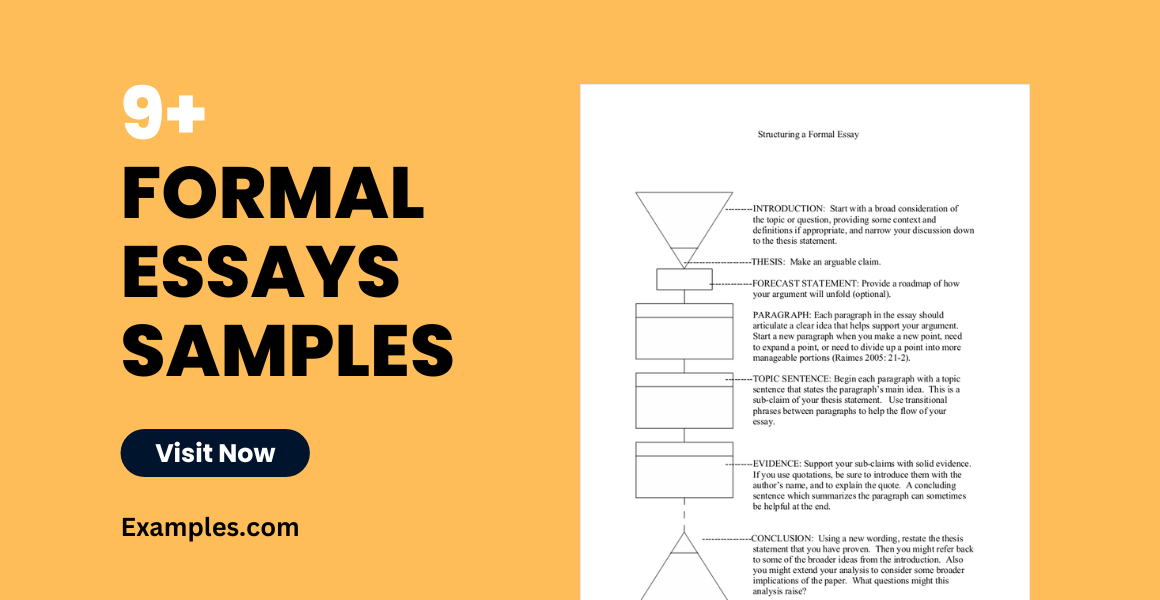
Within the activities that you have to deal with in your entire life, there are certain instances where you will be required to write an essay . This is the reason why you have to be knowledgeable on how to construct different kinds of essays so you can easily create a particular one when necessary. One type of essay that is usually asked by entities to be written is a formal essay. A formal essay is commonly associated with academic essay examples and other educational writing activities. However, the usage of a formal essay is not limited to that as it can be used in professional researchers, business transactions, and other corporate undertakings.
It is essential for a formal essay to inform its audience about a particular matter. More so, it should be composed of details that can persuade the readers to believe what the writer is saying. Refer to the downloadable samples of formal essays that are available in this post so you can have references and guides if you have been tasked to create this specific essay and is unaware of what to do.
Formal Student Profile Essay Sample
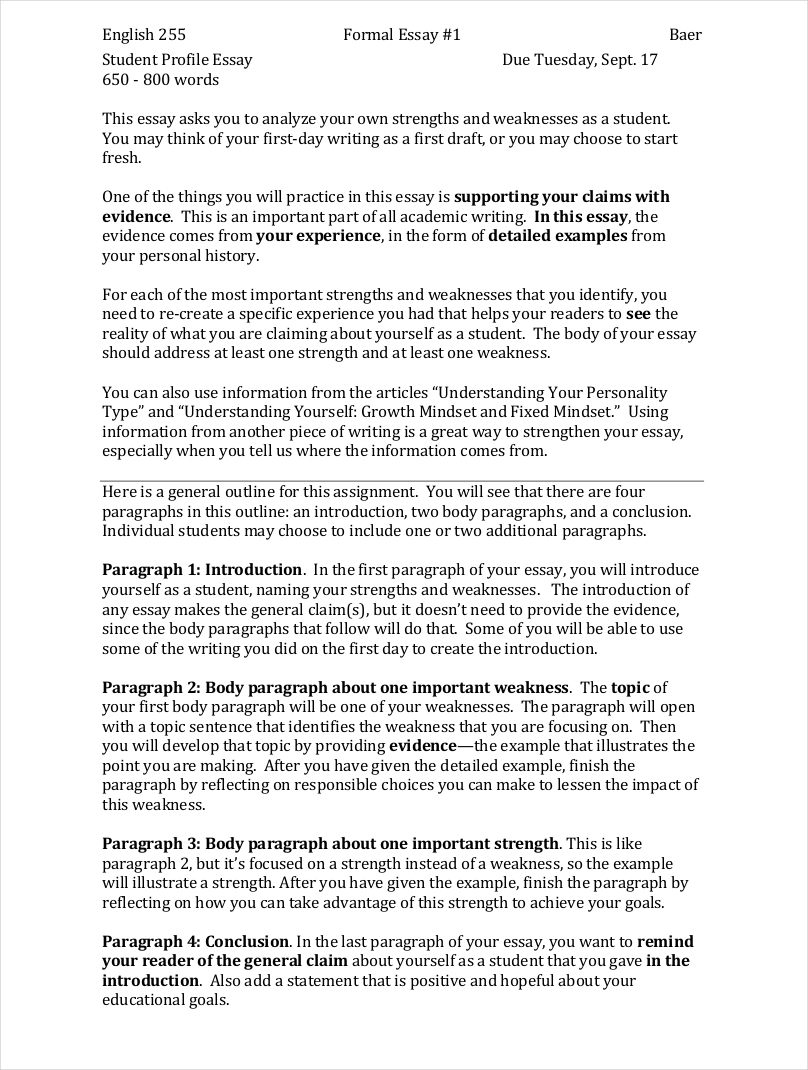
Size: 65 KB
Formal Essay Sample Guide
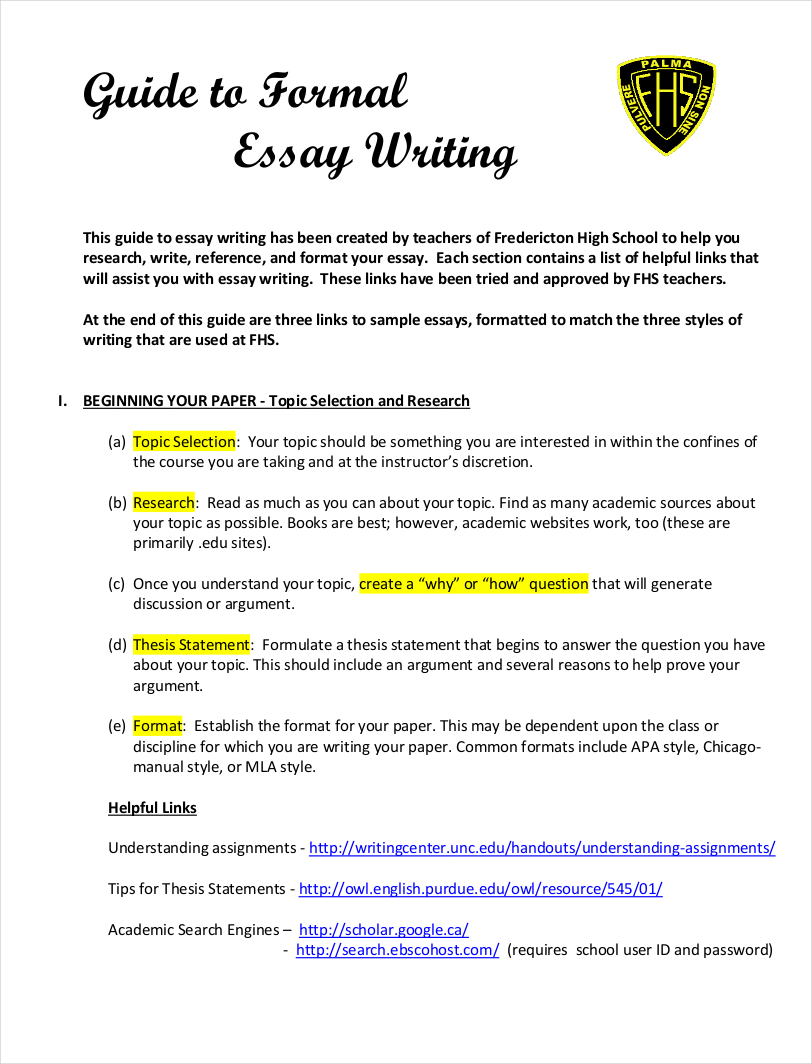
Size: 209 KB
Components of a Formal Essay Introduction
Compared to how a descriptive essay can be deemed appealing, one of the things that you always have to give focus on when creating a formal essay is the introduction that you will use. First impressions play a vital role in how your target readers will create their perception of your writing. Just as how the physical appearance of people tend to be the factor that can affect your first impression about them, the introduction of your essay can also be the means on how your formal essay can be perceived and initially judged.
You need to create a formal essay introduction that is outstanding. It needs to get the attention of your readers in a way that is not overwhelming. You need to consider different factors when doing your introduction so you can ensure that your formal essay can have a good start. Here are some of the components of a formal essay introduction that you need to be aware of:
- Statistics or research results either coming from the government or reliable non-profit organizations
- Hard hitting questions that are relevant to your topic discussion
- Famous quotations from people whose life works are related to what you will be talking about
- Use another sentence to provide information about your topic. Your readers need to have a basic background information about what they can expect with regards the content of your formal essay. This should contain details that can be helpful in providing your readers an idea of why it is relevant for them to continue reading your written output. One sentence is enough as your presentation only requires a few words to be done. Again, focus on the main information that you would like to talk about so that your readers will not be misled regarding the content of your formal essay.
- Lastly, incorporate your thesis statement in your introduction. It will be best if you will end your introduction with a thesis statement. This is for the reason that it can represent the main idea of your essay. If you will be able to present the major purpose of your essay and the actual point of discussion, then it will be easier for you to connect with your readers. The initial impact that your introduction can provide can say a lot about how you can direct the attention of your prospective audience. With a strong thesis statement, your formal essay is sure to be off to a good start.
Simple Formal Essay Sample

Size: 102 KB
Formal Presentation Essay Sample
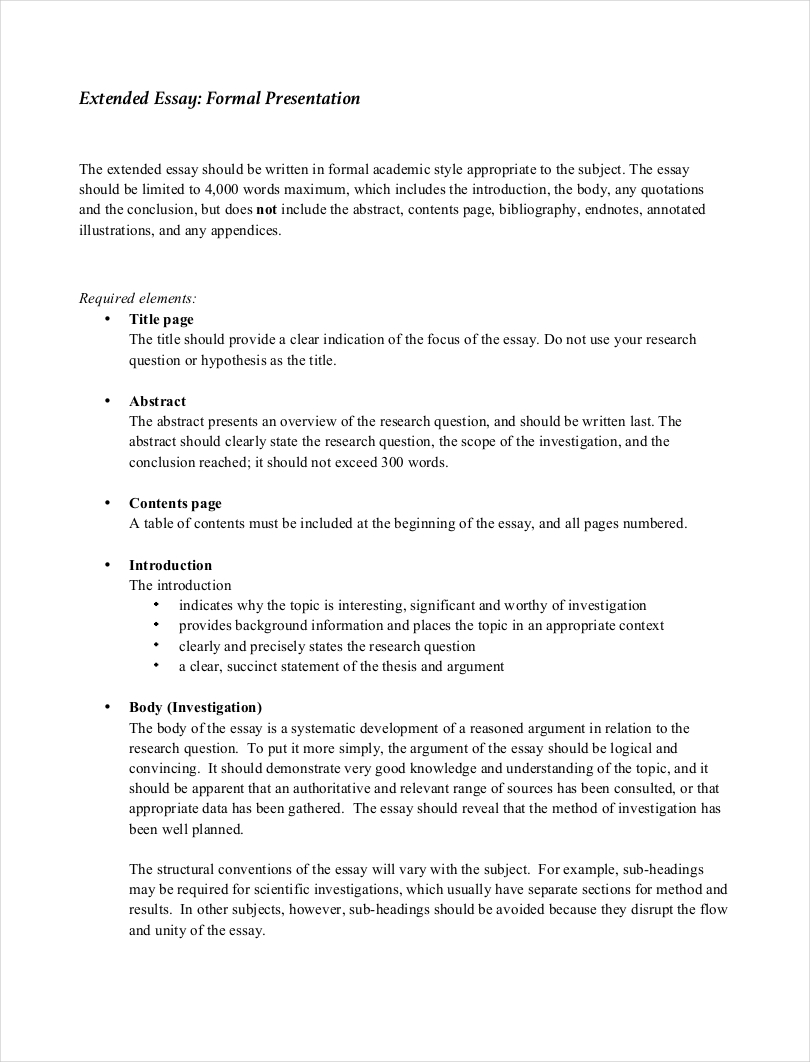
Size: 106 KB
How to Create a Formal Essay
Since a formal essay should always be based on factual information, it tends to be more objective, precise and direct to the point compared to other essays. With this, formatting a formal essay requires in-depth knowledge about the topic as well as about the proper format or content flow that should be used to cohesively put together important information. Here is how you can easily format the information that you would like to present in a formal essay may it be a college essay or a professional/corporate requirement:
- Create an introduction which can provide the topic of your discussion. We have already given you an idea on how you can formulate an effective introduction. It all boils down to how you will incorporate these ideas to your actual writing. Your introduction may not give a lot of details when compared to the body of you essay but it certainly can convince your readers to continue reading which can make your work more usable and relevant.
- Each paragraph should contain a subtopic that is related to your discussion. This can make your discussion more organized.
- Ensure that your body will have factual details that can support your topic or subject. You have to make sure that the information that you will give to your readers are real so your essay will be deemed credible.
- Always create a body that conveys ideas related to the thesis statement that you have created. With each topic statement, the connection of both your resources and relevant opinions should be evident.
- Make a conclusion that can summarize the entire essay. If you want to create an efficient essay conclusion, it is suggested for you to restate your thesis statement. This can remind your readers of the discussion that you just had in your essay’s body. Also, it will allow them to connect the purpose of the essay to what you have actually come up with. Your conclusion should also summarize all your main points so you can fully present your stand with regards the subject that you talked about.
Creating the format of your formal essay is easy. However, you have to make sure that your objective for writing the essay is realized. Think of the things that you need to discuss so you can put them in their proper places. Organization within the writing procedures can help you to be more focused on what to discuss first and what to give importance and focus on.
Sample Formal Essay Structure
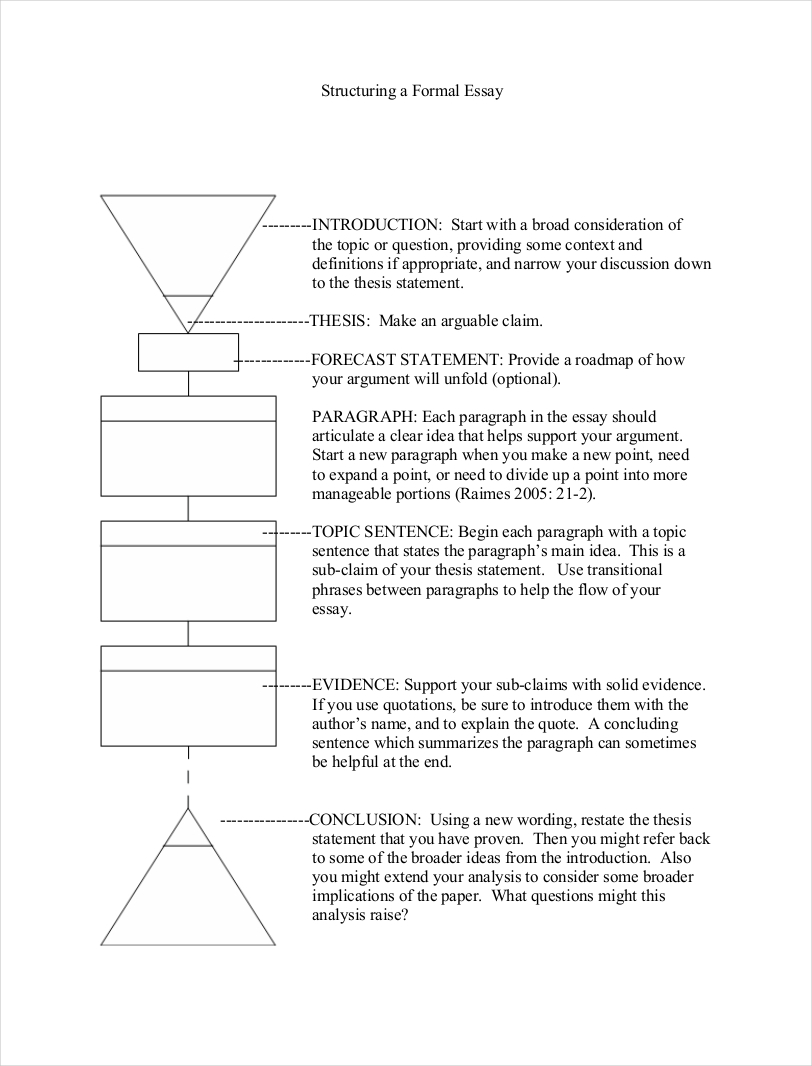
Size: 42 KB
Formal Essay Example
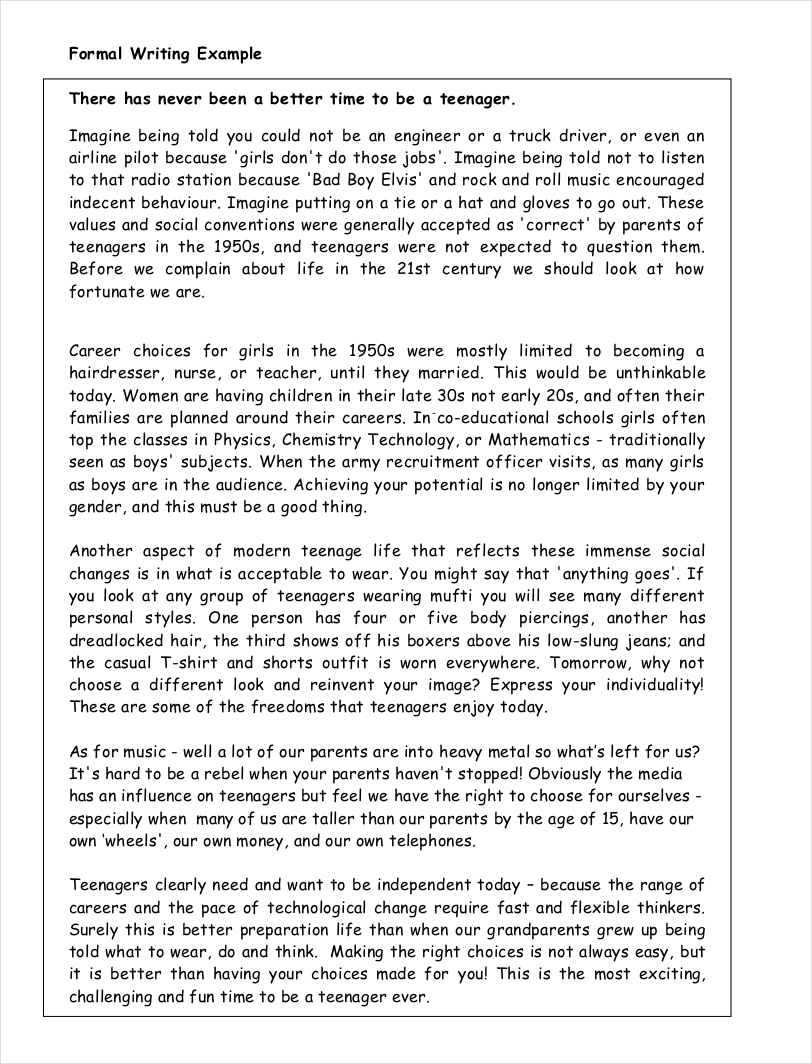
Size: 61 KB
How to Make Your Formal Essay Outstanding Through Proper Language Selection
Writing an essay is not just about its thought, content, and format. Aside from these major factors of essay writing, you also have to be keen when selecting the language to use. May it be in the educational and professional field, using the appropriate language when writing your formal essay can affect the entirety of the document.
You need to make sure that the language that you will use is formal and business-like. This is not only used for writing a formal essay as it can also apply to comparative essay creation and other writing activities. The language that you will incorporate into your essay can make your formal essay stand out if you will be aware of these items:
- Choose to use words that are formal in nature. Formal vocabulary can help your sentences, phrases, and paragraphs to be structured in a way that it will look more fitting as an academic document.
- As much as possible, veer away from using a first person standpoint. Always be reminded that your main task is to highlight and support your thesis statement. Both nouns and pronouns that are in the first person can actually make your essay less credible as it will sound like what you are stating are baseless or just your own opinion.
- Use words that can formally support your statements. It is essential for your language to have a precise interpretation of your essay and its tone. Being able to do this can help your formal essay to be more put together
- Use a language that is relevant to the needs of your target readers. Avoid slang, jargon, and colloquial terms which may not possibly be understood by your readers. You need to create a proper connection with your readers which is the reason why your language is very important to be considered.
Readers, though interested in the topic that you are writing about, can be offended or feel disinterested if they will find that your language is not appropriate for a particular discussion or written transaction. Hence, you need to be responsible enough as a writer when it comes to choosing your language.
Sample Formal Essay Format

Size: 48 KB
Extended Formal Essay Guide
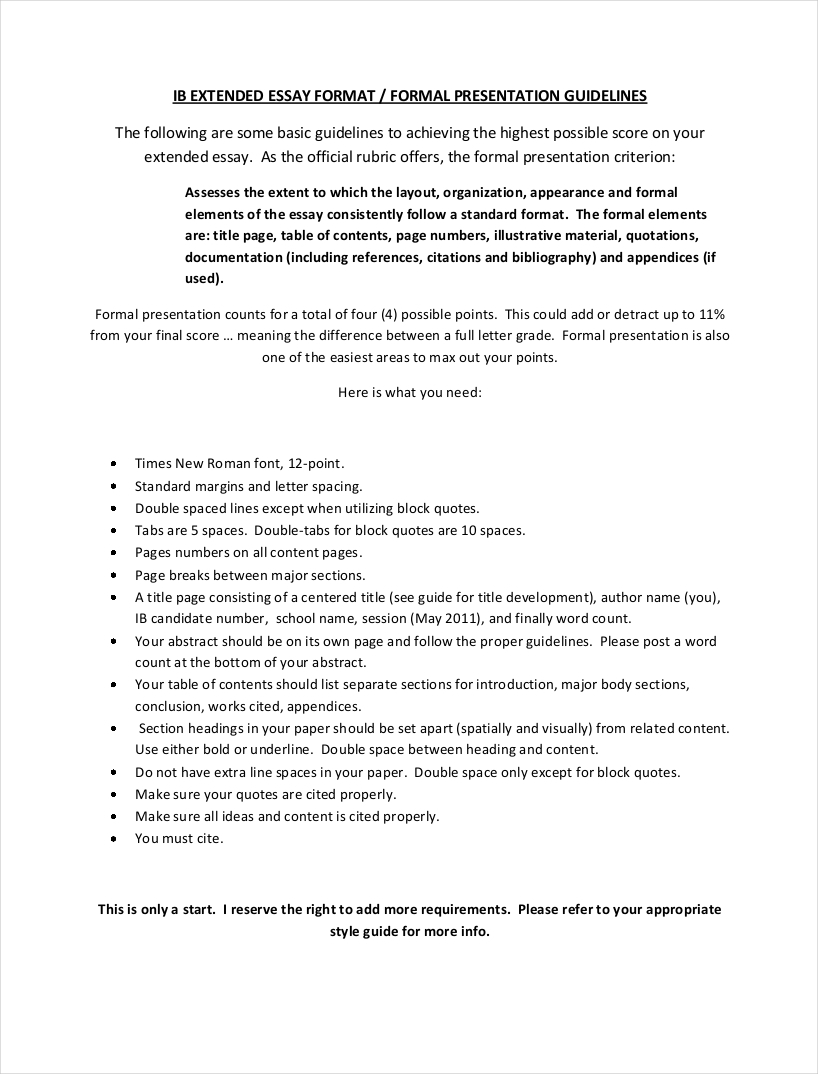
Size: 170 KB
Guidelines in Writing a Formal Essay
Just like any other kinds of essays, there are no strict rules that are irreplaceable. The way that you create a formal essay will always vary from situation to situation. Within the entirety of your formal essay writing, it is for sure that you might commit common essay mistakes . Listed below are some of the guidelines that you may incorporate into your writing so that your formal essay can look as professional as possible:
- Do not use redundant phrases. Repeating topics or content theme can make your formal essay boring. Repetitive statements can also irritate or bore your readers.
- Use samples of formal essays as your writing guides. If you have no idea on how to create a formal essay, it will be easier for you to create one if you are guided by downloadable samples. Having a reference when doing your own formal essay can help you become more efficient in the entire writing process.
- If samples are not enough to guide you, have the freedom to use templates. There are some templates that already contain a formal essay content. Make sure that you will remove these as all you need from the template is the guideline on how to format the document. More so, refer to the instructions that are given to you so you can incorporate it in the format that you will use.
Formal Essay Rubric Sample

Size: 98 KB
Formal Literary Essay Sample
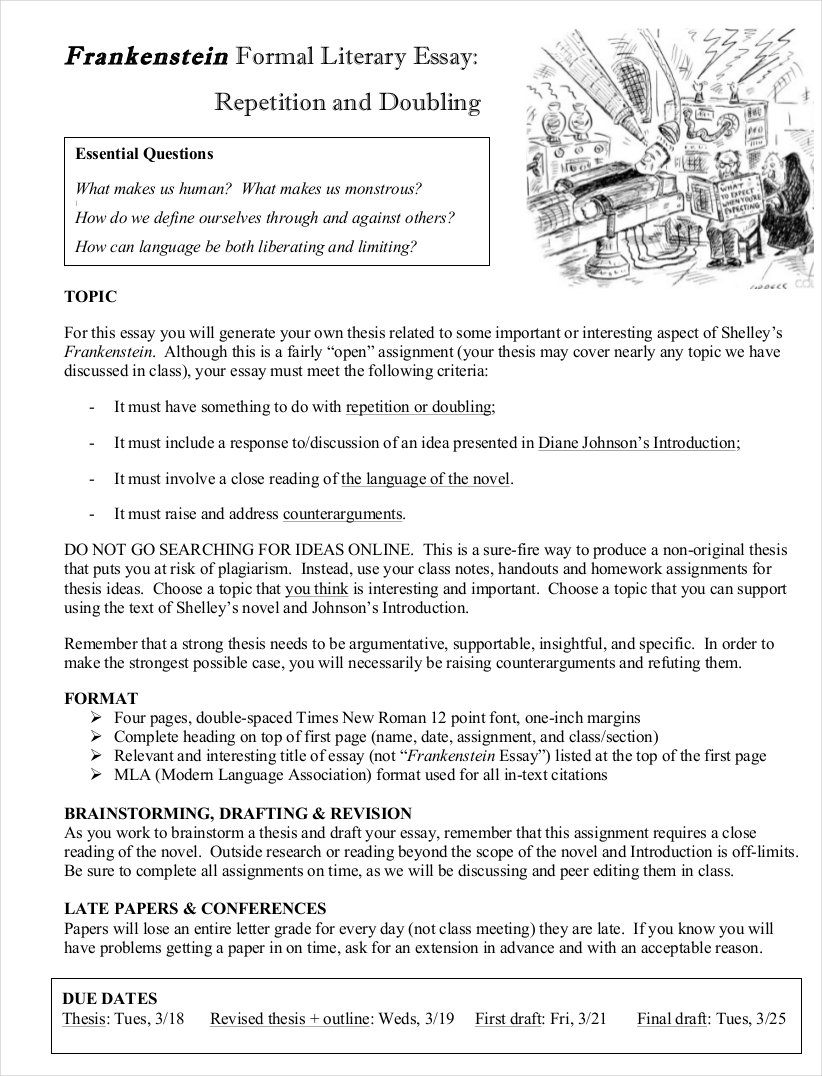
Size: 211 KB
A standardized and comprehensive formal essay is very appealing to readers. Hence, always be consistent with your discussion and the presentation flow that you will follow. Your formal essay can represent your style as a writer which is the main reason why you always have to incorporate credible language, forms, and materials in your writing. Being able to immerse yourself in writing a formal essay in the most effective manner can help you grow as a writer. This will enable you to acquire new skills and develop new opportunities for academic or professional growth.
If you are already prepared to write a formal essay, make use of our samples as well as the tips that we have provided in this post. Review your formal essay before submitting it so you can correct grammatical errors and other mistakes. Writing a formal essay should not be a burden to you. Enjoy the process and learn from everything that you will go through. Once you already get the gist of writing this type of essay, it will be very easy for you to repeat the process for your next writing activities.
Formal Essay Generator
Text prompt
- Instructive
- Professional
Write a Formal Essay on the significance of Shakespeare's works in modern literature.
Discuss the ethical implications of genetic engineering in a Formal Essay.
Trying to devise a structure for your essay can be one of the most difficult parts of the writing process. Making a detailed outline before you begin writing is a good way to make sure your ideas come across in a clear and logical order. A good outline will also save you time in the revision process, reducing the possibility that your ideas will need to be rearranged once you've written them.
The First Steps
Before you can begin outlining, you need to have a sense of what you will argue in the essay. From your analysis and close readings of primary and/or secondary sources you should have notes, ideas, and possible quotes to cite as evidence. Let's say you are writing about the 1999 Republican Primary and you want to prove that each candidate's financial resources were the most important element in the race. At this point, your notes probably lack much coherent order. Most likely, your ideas are still in the order in which they occurred to you; your notes and possible quotes probably still adhere to the chronology of the sources you've examined. Your goal is to rearrange your ideas, notes, and quotes—the raw material of your essay—into an order that best supports your argument, not the arguments you've read in other people's works. To do this, you have to group your notes into categories and then arrange these categories in a logical order.
Generalizing
The first step is to look over each individual piece of information that you've written and assign it to a general category. Ask yourself, "If I were to file this in a database, what would I file it under?" If, using the example of the Republican Primary, you wrote down an observation about John McCain's views on health care, you might list it under the general category of "Health care policy." As you go through your notes, try to reuse categories whenever possible. Your goal is to reduce your notes to no more than a page of category listings.
Now examine your category headings. Do any seem repetitive? Do any go together? "McCain's expenditure on ads" and "Bush's expenditure on ads," while not exactly repetitive, could easily combine into a more general category like "Candidates' expenditures on ads." Also, keep an eye out for categories that no longer seem to relate to your argument. Individual pieces of information that at first seemed important can begin to appear irrelevant when grouped into a general category.
Now it's time to generalize again. Examine all your categories and look for common themes. Go through each category and ask yourself, "If I were to place this piece of information in a file cabinet, what would I label that cabinet?" Again, try to reuse labels as often as possible: "Health Care," "Foreign Policy," and "Immigration" can all be contained under "Policy Initiatives." Make these larger categories as general as possible so that there are no more than three or four for a 7-10 page paper.
With your notes grouped into generalized categories, the process of ordering them should be easier. To begin, look at your most general categories. With your thesis in mind, try to find a way that the labels might be arranged in a sentence or two that supports your argument. Let's say your thesis is that financial resources played the most important role in the 1999 Republican Primary. Your four most general categories are "Policy Initiatives," "Financial Resources," "Voters' Concerns," and "Voters' Loyalty." You might come up with the following sentence: ÒAlthough McCain's policy initiatives were closest to the voters' concerns, Bush's financial resources won the voters' loyalty.Ó This sentence should reveal the order of your most general categories. You will begin with an examination of McCain's and Bush's views on important issues and compare them to the voters' top concerns. Then you'll look at both candidates' financial resources and show how Bush could win voters' loyalty through effective use of his resources, despite his less popular policy ideas.
With your most general categories in order, you now must order the smaller categories. To do so, arrange each smaller category into a sentence or two that will support the more general sentence you've just devised. Under the category of "Financial Resources," for instance, you might have the smaller categories of "Ad Expenditure," "Campaign Contributions" and "Fundraising." A sentence that supports your general argument might read: "Bush's early emphasis on fundraising led to greater campaign contributions, allowing him to have a greater ad expenditure than McCain."
The final step of the outlining process is to repeat this procedure on the smallest level, with the original notes that you took for your essay. To order what probably was an unwieldy and disorganized set of information at the beginning of this process, you need now only think of a sentence or two to support your general argument. Under the category "Fundraising," for example, you might have quotes about each candidate's estimation of its importance, statistics about the amount of time each candidate spent fundraising, and an idea about how the importance of fundraising never can be overestimated. Sentences to support your general argument might read: "No candidate has ever raised too much money [your idea]. While both McCain and Bush acknowledged the importance of fundraising [your quotes], the numbers clearly point to Bush as the superior fundraiser [your statistics]." The arrangement of your ideas, quotes, and statistics now should come naturally.
Putting It All Together
With these sentences, you have essentially constructed an outline for your essay. The most general ideas, which you organized in your first sentence, constitute the essay's sections. They follow the order in which you placed them in your sentence. The order of the smaller categories within each larger category (determined by your secondary sentences) indicates the order of the paragraphs within each section. Finally, your last set of sentences about your specific notes should show the order of the sentences within each paragraph. An outline for the essay about the 1999 Republican Primary (showing only the sections worked out here) would look something like this:
I. POLICY INITIATIVES
II. VOTERS' CONCERNS
III. FINANCIAL RESOURCES
A. Fundraising
a. Original Idea
b. McCain Quote/Bush Quote
c. McCain Statistics/Bush Statistics
B. Campaign Contributions
C. Ad Expenditure
IV. VOTERS' LOYALTY
Copyright 2000, David Kornhaber, for the Writing Center at Harvard University
Purdue Online Writing Lab Purdue OWL® College of Liberal Arts
APA Sample Paper

Welcome to the Purdue OWL
This page is brought to you by the OWL at Purdue University. When printing this page, you must include the entire legal notice.
Copyright ©1995-2018 by The Writing Lab & The OWL at Purdue and Purdue University. All rights reserved. This material may not be published, reproduced, broadcast, rewritten, or redistributed without permission. Use of this site constitutes acceptance of our terms and conditions of fair use.
Note: This page reflects the latest version of the APA Publication Manual (i.e., APA 7), which released in October 2019. The equivalent resource for the older APA 6 style can be found here .
Media Files: APA Sample Student Paper , APA Sample Professional Paper
This resource is enhanced by Acrobat PDF files. Download the free Acrobat Reader
Note: The APA Publication Manual, 7 th Edition specifies different formatting conventions for student and professional papers (i.e., papers written for credit in a course and papers intended for scholarly publication). These differences mostly extend to the title page and running head. Crucially, citation practices do not differ between the two styles of paper.
However, for your convenience, we have provided two versions of our APA 7 sample paper below: one in student style and one in professional style.
Note: For accessibility purposes, we have used "Track Changes" to make comments along the margins of these samples. Those authored by [AF] denote explanations of formatting and [AWC] denote directions for writing and citing in APA 7.
APA 7 Student Paper:
Apa 7 professional paper:.
